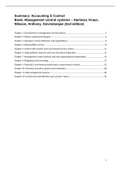Summary: Accounting & Control
Book: Management control systems – Hartman, Kraus,
Nilsson, Anthony, Govindarajan (2nd edition)
Chapter 1: Introduction to management control systems......................................................................2
Chapter 2: Mission, goals and strategies................................................................................................3
Chapter 3: Managers, human behaviour and organizations...................................................................6
Chapter 4: Responsibility centres...........................................................................................................8
Chapter 5: Control with transfer prices and shared service centres.....................................................11
Chapter 6: Organizational structure and cross-functional integration.................................................15
Chapter 7: Management control systems and inter-organizational relationships................................19
Chapter 8: Budgeting and forecasting..................................................................................................21
Chapter 9: Financial & non-financial performance measurement systems..........................................25
Chapter 10: Monetary incentive systems and motivation....................................................................28
Chapter 11: Risk management systems................................................................................................30
Chapter 12: Control and controllership: past, present, future.............................................................33
1
,Chapter 1: Introduction to management control systems
Management control system: comprising a combination of control practices designed and
implemented by top managers to increase the probability that lower-level managers and employees
will behave in ways consistent with the organization’s mission, goals and strategies.
focus our attention on formal control practices that are deliberately designed by top
managers.
Examples of control practices: budgets, mission statements, transfer pricing arrangements,
performance measures, reward systems.
Control practices can usefully be divided into three types:
- input controls:
- throughput controls:
- output controls
Top managers need to systematically think through how to achieve an appropriate ‘balance’ between
a coercive role of management control systems (i.e., a control device for use by top managers) and
an enabling role (premised on a need to enhance the lower-level managers and employees’
capabilities, and to capitalize on their intelligence by giving them the freedom to innovate and
engineer solutions to concrete problems).
2
,Chapter 2: Mission, goals and strategies
Shareholder view: organizations exist to fulfil the demands of the owners
Stakeholder view: organizations exist to fulfil not just the demands of the owners, but for several
stakeholder groups.
Stakeholders contribute to and benefit from the organization in question. (those stakeholders are
owners, customers, employees, suppliers, lenders, society)
Corporate governance relates to the shareholder view, it deals with how owners act to influence the
organization to work in the best interest of the owners.
Corporate social responsibility, relates to stakeholder view. Could be seen as a reaction to the strong
shareholder and corporate governance trends, but may also be explained by changes in society.
Two important drivers behind the increased focus on corporate governance:
1. expansion of new owner categories, such as pension funds and mutual funds
2. increased legislation, such as SOX
Corporate governance can be executed in a number of different ways, including the appointment of
board members, meetings between owner representatives and managers, auditing or, quite simply,
the owners selling their shares if they are not satisfied
CSR is about an organization’s voluntary concern about social and environmental issues.
The drivers behind the increased interest in these issues during this millennium include globalization
and increased pressure from stakeholders including the media. In order to protect themselves from
bad publicity, most organizations have started to work systematically with CSR. Just like corporate
governance there are many methods to use when working with CSR, including formulation of a code
of conduct, sustainability reporting, and nurturing of organizational values and culture in line with
good ethics.
3 types of arguments for working with CSR:
1. ethical: fair to stakeholder groups besides owners and more sustainable
2. business: good for business to have happy employees and offer sustainable products to
customers
3. fashion: everyone does it
Mission: reason why the organization exists
Organizational goals: (more concrete than mission)
- financial goals: often linked to owners
- strategic goals: often relate to mission and financial goals
Financial goals:
- goals of owner: high profitability & low risk
- Are related, for instance, to how fruitful the owner’s investment is
Strategic goals:
- Often describe how the organization is going to build or sustain competitive advantage
3
, Profitability: (for-profit organizations)
- measures to what extent the owners get a good return on the capital that they have put into
the company
- return on investment = profit / invested capital
invested capital = total assets
- return on equity = net profit / equity
Strategy:
- Deliberate strategy: the design or choice of strategy is the results of a systematic analysis.
Forward looking, first design or choose strategy, then implement.
o Design perspective: Strategy should be designed to fit the organization’s
environment and capabilities.
o Positioning perspective: focus is more on choosing a more generic strategy than to
carefully plan and design a very specific strategy suited to the specific organization.
- Emerging strategy: strategies not successfully implemented or work not work very well in
practice.
Types of strategies:
- Corporate strategy: is about being in the right mix of business. (where to compete)
- Business unit strategy: is about how to compete in a particular industry.
3 categories of corporate strategy:
- Single industry firm
- Firms operating in number of industries: Related diversified firms
- Unrelated business firm: unrelated diversified firms or conglomerates
According to Porter’s generic strategy, the structure of an industry should be analysed in terms of the
collective strength of five competitive forces (BU strategy)
1. The intensity of the market
2. The bargaining power of customers
3. The bargaining power of suppliers
4. Threat from substitutes
5. The treat of new entry
Porter claims that the business unit has two generic ways of responding to the opportunities in the
external environment and developing a sustainable competitive advantage: low cost and
differentiation.
3 contingencies:
- Environment
- Strategy
- Technology
‘We live in a VUCA world’, which stands for:
o Volatility: the world is changing very fast, perhaps faster than ever
o Uncertainty: it is very difficult to foresee how the world is going to change
o Complexity: change is driven by several, contradictory forces
o Ambiguity: reality is blurred, and cause-effect chains are unclear
4





